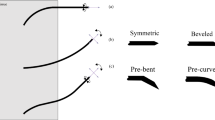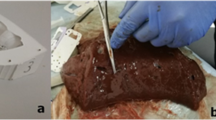Abstract
Radiofrequency ablation (RFA) guided by X-ray images aims to relieve herniated disc pain with minimal invasiveness and fast recovery. It requires an accurate and fast positioning of the puncture needle. We propose a teleoperated robotic system for percutaneous puncture to support RFA. We report the kinematics modelling and workspace analysis of the proposed system, which comprises preliminary and accurate positioning mechanisms. Preliminary positioning mechanism automatically drives the needle to the puncture area, and accurate positioning is then achieved by teleoperation under the guidance of X-ray images. We calculate the teleoperation workspace of the robot system using a spatial search algorithm and quantitatively analyze the optimal structural parameters aiming to maximize the workspace. The workspace of the proposed robot system complies with clinical requirements to support RFA.
Similar content being viewed by others
References
ZENG Z, YAN M, DAI Y, et al. Percutaneous bipolar radiofrequency thermocoagulation for the treatment of lumbar disc herniation [J]. Journal of Clinical Neuroscience, 2016, 30: 39–43.
SUN R, YANG W, LIU Y, et al. Clinical study of percutaneous radiofrequency target thermocoagulation in treatment for lumbar disc herniation [J]. Orthopedic Journal of China, 2011, 19(19): 1612–1614 (in Chinese).
DEVITO D P, KAPLAN L, DIETL R, et al. Clinical acceptance and accuracy assessment of spinal implants guided with SpineAssist surgical robot [J]. Spine, 2010, 35(24): 2109–2115.
LEFRANC M, CAPEL C, PRUVOT A S, et al. The impact of the reference imaging modality, registration method and intraoperative flat-panel computed tomography on the accuracy of the ROSA® stereotactic robot [J]. Stereotactic and Functional Neurosurgery, 2014, 92(4): 242–250.
KOSTRZEWSKI S, DUFF J M, BAUR C, et al. Robotic system for cervical spine surgery [J]. The International Journal of Medical Robotics and Computer Assisted Surgery, 2012, 8(2): 184–190.
FRANCO E, RISTIC M, REA M, et al. Robotassistant for MRI-guided liver ablation: A pilot study [J]. Medical Physics, 2016, 43(10): 5347–5356.
BALICKI M, KYNE S, TOPOREK G, et al. Design and control of an image-guided robot for spine surgery in a hybrid OR [J]. The International Journal of Medical Robotics and Computer Assisted Surgery, 2020, 16(4): e2108.
LAN H, TAN Z, LI K, et al. Intramedullary nail fixation assisted by orthopaedic robot navigation for intertrochanteric fractures in elderly patients [J]. Orthopaedic Surgery, 2019, 11(2): 255–262.
LIU H, DUAN S, LIU S, et al. Robot-assisted percutaneous screw placement combined with pelvic internal fixator for minimally invasive treatment of unstable pelvic ring fractures [J]. The International Journal of Medical Robotics and Computer Assisted Surgery, 2018, 14(5): e1927.
GOSSELIN C, SCHREIBER L T. Kinematically redundant spatial parallel mechanisms for singularity avoidance and large orientational workspace [J]. IEEE Transactions on Robotics, 2016, 32(2): 286–300.
FURQAN M, SUHAIB M, AHMAD N. Studies on Stewart platform manipulator: A review [J]. Journal of Mechanical Science and Technology, 2017, 31(9): 4459–4470.
HU B, ZHANG L, YU J. Kinematics and dynamics analysis of a novel serial-parallel dynamic simulator [J]. Journal of Mechanical Science and Technology, 2016, 30(11): 5183–5195.
KİZİR S, BİNGÜL Z. Design and development of a Stewart platform assisted and navigated transsphenoidal surgery [J]. Turkish Journal of Electrical Engineering & Computer Sciences, 2019, 27: 961–972.
BONEV I A, RYU J. A geometrical method for computing the constant-orientation workspace of 6-PRRS parallel manipulators [J]. Mechanism and Machine Theory, 2001, 36(1): 1–13.
ARROUK K A, BOUZGARROU B C, GOGU G. CAD-based unified graphical methodology for solving the main problems related to geometric and kinematic analysis of planar parallel robotic manipulators [J]. Robotics and Computer-Integrated Manufacturing, 2016, 37: 302–321.
ZHOU Y, NIU J, LIU Z, et al. A novel numerical approach for workspace determination of parallel mechanisms [J]. Journal of Mechanical Science and Technology, 2017, 31(6): 3005–3015.
SAPUTRA V B, ONG S K, NEE A Y C. A swarm optimization approach for solving workspace determination of parallel manipulators [J]. Robotica, 2015, 33(3): 649–668.
Author information
Authors and Affiliations
Corresponding author
Additional information
Foundation item: the National Natural Science Foundation of China (No. 51575343)
Rights and permissions
About this article
Cite this article
Hu, B., Lin, Y., Chen, S. et al. Teleoperated Puncture Robot System: Preliminary Design and Workspace Analysis. J. Shanghai Jiaotong Univ. (Sci.) 27, 15–23 (2022). https://doi.org/10.1007/s12204-021-2368-3
Received:
Accepted:
Published:
Issue Date:
DOI: https://doi.org/10.1007/s12204-021-2368-3




